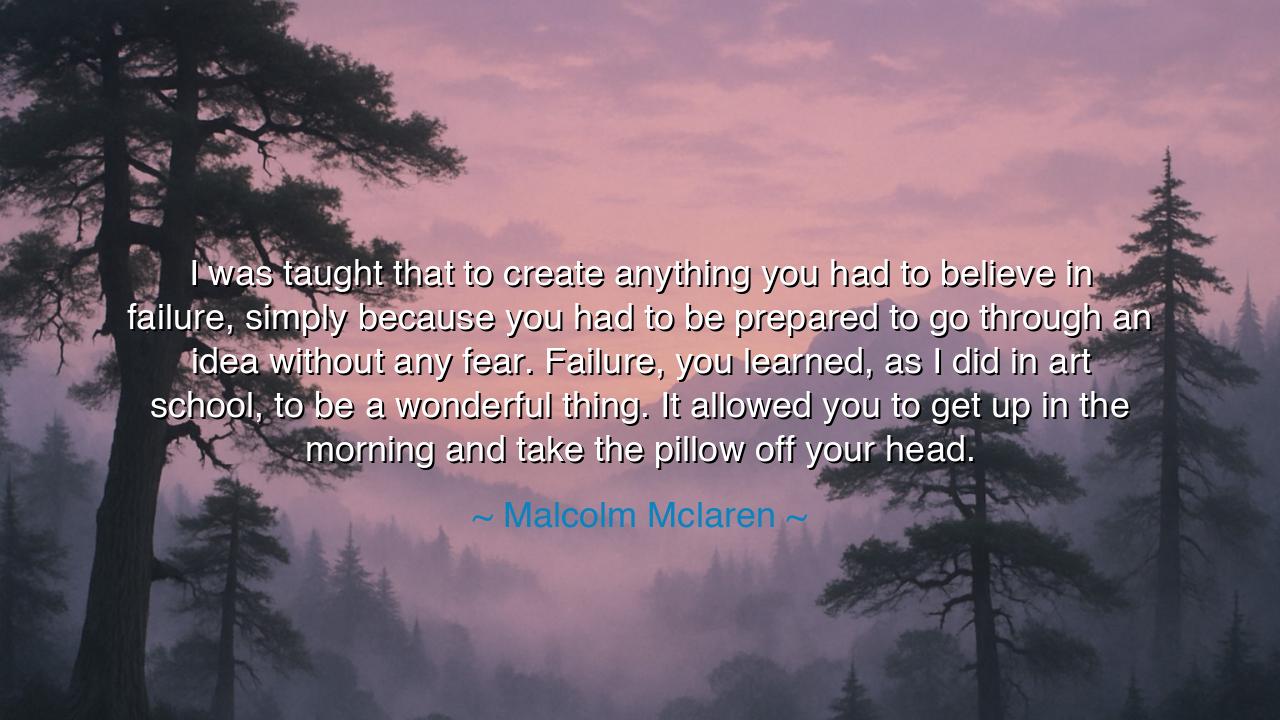
I was taught that to create anything you had to believe in
I was taught that to create anything you had to believe in failure, simply because you had to be prepared to go through an idea without any fear. Failure, you learned, as I did in art school, to be a wonderful thing. It allowed you to get up in the morning and take the pillow off your head.






“I was taught that to create anything you had to believe in failure, simply because you had to be prepared to go through an idea without any fear. Failure, you learned, as I did in art school, to be a wonderful thing. It allowed you to get up in the morning and take the pillow off your head.” Thus declared Malcolm McLaren, provocateur, impresario, and the restless spirit behind the birth of punk. His words are not a lament, but a hymn to failure, the stern yet generous teacher who guides those who dare to create. In them we hear the wisdom of one who understood that greatness is not forged in safety, but in risk, and that to live as an artist is to embrace defeat as a companion, not as an enemy.
The origin of this saying lies in McLaren’s early years in art school, where he absorbed not only technique but also philosophy. In those studios, he discovered that creativity was not about avoiding mistakes, but about surrendering to them, allowing them to become part of the process. Failure, to him, was not the end of the journey but the necessary terrain through which the path of originality passes. To fear failure was to remain silent, to keep the pillow pressed over one’s head. But to embrace it was to rise each morning and dare again.
The ancients, too, spoke of this paradox. Did not Aristotle write that “he who has never made a mistake has never tried anything new”? And did not the Stoics remind their disciples that hardship and error are the very soil in which virtue grows? The Roman general who stumbled in one campaign often returned wiser and stronger in the next. The artist, the inventor, the philosopher—all knew that failure is the forge of excellence. McLaren’s words stand in this long tradition, translated into the language of art and rebellion.
History offers us countless examples. Thomas Edison, when asked about the thousands of failed attempts before inventing the lightbulb, famously replied, “I have not failed. I’ve just found 10,000 ways that won’t work.” For him, as for McLaren, failure was fuel, not defeat. Consider also the great painter Vincent van Gogh, whose works were unappreciated in his lifetime, who endured rejection and despair, yet continued to paint with unrelenting passion. His “failure” in the eyes of the world became, in time, the foundation of his eternal legacy.
From this we learn that failure is not a curse but a companion. It clears the path of fear, allowing us to act boldly, to try without restraint. Without it, we remain trapped in hesitation, paralyzed by the dread of imperfection. McLaren reminds us that failure is “a wonderful thing” because it frees the artist from the tyranny of expectation. It whispers: you have nothing to lose but silence, and everything to gain in expression.
Practical wisdom follows: seek failure, not as destruction, but as growth. If you write, let your first drafts be clumsy. If you paint, let your strokes be wild. If you live, let your attempts falter, for each stumble will teach you more than stillness ever could. Begin your mornings with the courage to be imperfect, and you will find the freedom McLaren described—the freedom to take the pillow off your head and face the day unafraid.
Thus, remember McLaren’s words: “To create anything you had to believe in failure.” This is not resignation but liberation. For those who embrace failure walk without fear, and those who walk without fear create boldly, live fully, and leave behind works that outlast time itself. Let failure be your teacher, your ally, and your guide—and you will rise each morning with courage, ready to shape the world anew.






AAdministratorAdministrator
Welcome, honored guests. Please leave a comment, we will respond soon